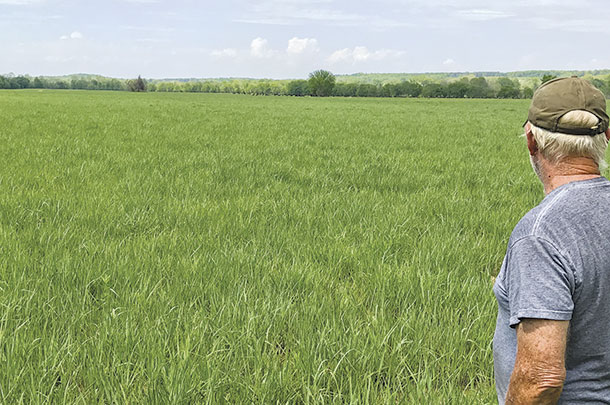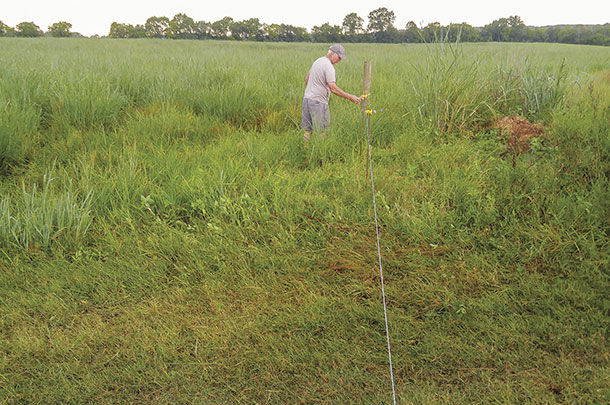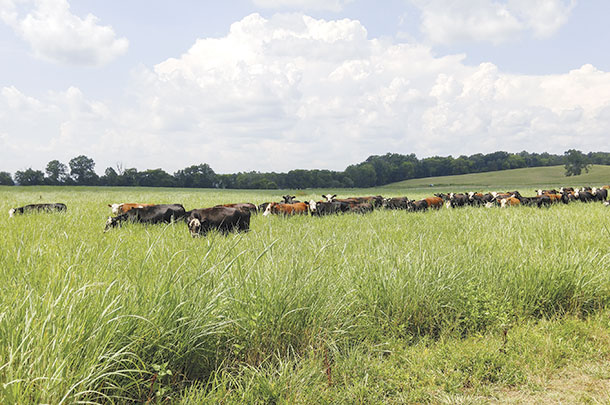These two neighbors in Charlotte County, Virginia, needed a grass that would grow with its toes in the water half the spring – maybe even up to its knees from time to time. A perennial would be nice, too. What to do? Neither of these cattle producers had an answer.
Meanwhile, up the road, Virginia extension professional Bob Jones was talking with me in his office. “Bob, do you know of any producers who would be willing to try a novel warm-season forage?” I asked. “I know a couple of boys who might be interested,” he said. “Good, innovative producers.” That was, as best as any of us can recall, back in 1992.
I met Tim Willis at his farm. He showed me a piece of his low grounds, a wet corner with rushes growing on it. “Switchgrass? Never heard of it,” he told me. “Will it grow there?” he asked, pointing to the wettest corner of his low grounds. Tim had not been born yesterday (back in ’92, that is), so he felt like a little proof of concept might be in order.
Three years later, my phone rang: “Pat, stop by the farm. I want to show you something.” What he showed me was, as best as I can recall, better than two dozen rolls on 3 acres – a bunch of hay. “I want to plant some more of this stuff; I believe it will work.”
Yup, I thought, another 10 to 20 acres would be a good step. “How much more, Tim?” I was surprised when he told me he was thinking of a modest increase – up to 150 acres. Robbie Tate had paid attention to Tim Willis’ 3-acre experiment as well and figured his soggy pasture along Roanoke Creek would be a great place to drop in 40 acres for his operation. Our work was cut out for us for the spring of 1996.
Blast from the past
Fast-forward 21 years, I got a call from Virginia NRCS Forage and Grassland agronomist J.B. Daniel. “Pat, we are planning a workshop at Tim Willis’ for sometime this summer. …” Now there was a blast from the past. I had not seen Bob Jones, Tim Willis or Robbie Tate in about 19 years, as best as I could recall.
To be honest, I assumed that, one way or another, the switchgrass would have played out and there would not be much to see. One picture later (Photo 1), I knew I had to slip back up to Virginia and see these guys and their forage management.

Both Tim Willis and Robbie Tate still have switchgrass pastures, fewer acres now and a few different fields in Robbie Tate’s case, but they are still providing abundant summer forage. Tim Willis, his son Sam, and their wives, Robin and Lauren, work together to manage about 300 mama cows on about 800 acres.
While most of their pasture is on the hills above the low ground, they are able to rest the hill pastures during summer when they move onto the switchgrass. Tim relies a great deal on strip grazing, using strategically placed water and pulling wire across 10-acre increments of switchgrass (Photo 2).

Because he does not want to calve near the river or in the tall grass, he typically pulls the cows off the switchgrass about Aug. 20 or so most years.
In the 21 years he has had the switchgrass, he cut some hay early once, but since then it has all been grazed. He has not had to spray or fertilize the switchgrass. He does burn his pasture off most years in spring – which is good for weed control and removes the late-summer growth from the previous year. Today, this pasture is thick, clean and very productive.
Thanks to the Willis’ hospitality, we ended up with a great couple of workshops. Seeing the resilience and productivity of the pasture was an eye-opener for those not familiar with switchgrass.
Seeing cattle graze at 3 p.m. in 90ºF-plus heat (Photo 3) was a welcome sight in the fescue belt, where summer grazing often takes a hit from the combination of heat and fescue toxicity.

The folks from the game department were treated to the sight and sounds of numerous grassland birds – species such as bobwhite and grasshopper sparrow that have declining populations and have a serious need of conservation.
As it turns out, native grass forages are a tool that has the benefit of being able to grow beef and bobwhites – helping cattlemen and helping wildlife conservation at the same time.
I encouraged Tim Willis to continue the burning – always a good practice with native grasses – and to consider possibly using his early season switchgrass for some weaned calves or replacement heifers, a great way to add pounds to growing classes of animals.
Sold on switchgrass
But what about in drought years – does switchgrass help in those summers? Tim observed, “In really dry summers, it’s great to have this. Everything else is stressed, and the switchgrass just keeps on comin’.” Agreeing, Robbie said, “It has saved me in several dry years. I haven’t found it hard to manage, and it will even hold up under some abuse.”
Tim has had a similar experience: “We just move them through on a regular basis with wire – not much to it.” The proof was in the pudding when he opened the next paddock to his cows; they moved quickly into the new piece of fresh forage. In about 15 minutes, all 300 cows had passed by. And on a still summer evening, hearing 200 cows grazing all at once is a pretty sound for a family who sells cattle by the pound.
Seeing such a productive pasture after 21 years was a great sight. I am glad I walked into Bob’s office back in the day and he introduced me to a couple of great producers. They have definitely weathered some droughts, put a bunch of pounds on a whole lot of cattle and found a solution to producing forage on low grounds. What a blessing to see old friends after so long.
Now just between you and me, I don’t think I have changed much in the past 21 years, but sure enough, Bob, Robbie and Tim – they all have a bit of gray in their hair, not like back in the day. ![]()
PHOTO 1: Tim Willis, a Charlotte County, Virginia, cow-calf producer, looks across his 21-year-old switchgrass pasture. Good grazing management and periodic spring fires have kept this pasture thick and productive.
PHOTO 2: Tim Willis has been using wire to strip-graze his 130 acres of switchgrass. He allows about 10 acres per paddock for his 300 cow-calf pairs. His cattle are used to the moves, which can be done quickly and efficiently, and the grass is maintained in good condition through timely moves.
PHOTO 3: Cattle are grazing Willis’ switchgrass at 3 p.m. on July 18 at 90ºF. Good levels of intake and an absence of elevated body temperatures associated with fescue toxicosis means more summer grazing and better animal performance than what can be provided during summer on fescue-based pastures. Photos by J.B. Daniel.
J.B. Daniel, a forage and grassland agronomist with Virginia NRCS, and Bob Jones, an extension specialist at the University of Virginia, also assisted in this article.

-
Patrick Keyser
- Professor - Director of the Center for Native Grasslands Management
- University of Tennessee Institute of Agriculture
- Email Patrick Keyser








